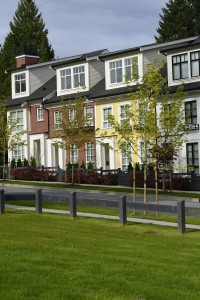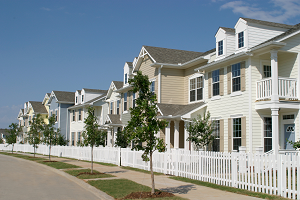 I can answer this in one sentence: a condominium is declared a condominium.
I can answer this in one sentence: a condominium is declared a condominium.
Yes, it is really that simple but I have read several articles on this topic and all missed this very important aspect. They have talked about building plans, owning the adjacent plot of land and homeowner’s associations but the bottom line is that in order for something to be called a condominium, it must be declared one.
Common Interest Communities
Common interest ownership means that the units have unit boundaries which the unit owners own exclusively and everything else (open areas, ponds, pool, tennis courts, roads, parking etc.) is collectively owned by all of the unit owners.
The areas outside of the unit boundaries are typically called common elements and are maintained collectively by all of the unit owners through a homeowner’s association (HOA). The unit owners pay common charges which fund a budget to maintain the common elements and other aspects of the community.
Townhouses
 A townhouse does not have to be a part of a common interest community. Each townhouse owner owns the unit (interior and exterior and is responsible for the insurance and maintenance of both), the land in the front and back of the unit and the parking, if there is any. In this case, there are no common elements and no community association.
A townhouse does not have to be a part of a common interest community. Each townhouse owner owns the unit (interior and exterior and is responsible for the insurance and maintenance of both), the land in the front and back of the unit and the parking, if there is any. In this case, there are no common elements and no community association.
This would be similar to a grouping of single-family homes that were smushed together from both sides to form one continuous building. None of the owners have a financial obligation to the others.
Conversely, if a townhouse building is under a form of common interest ownership and it is not a condominium, it might be referred to as a planned community or PUD (the name varies amongst the states). In this case, there would be a Homeowner’s Association that would pool funds for the maintenance and upkeep of the common elements.
If a townhouse building is under a form of common interest ownership and it is declared a condominium, then it is a condominium.
Condominiums
 Condominiums are a form of common interest ownership as stated above. The legal documents would specifically state that the community is a condominium. There would be an HOA responsible for the insurance, maintenance and upkeep of the common elements.
Condominiums are a form of common interest ownership as stated above. The legal documents would specifically state that the community is a condominium. There would be an HOA responsible for the insurance, maintenance and upkeep of the common elements.
I think it becomes confusing because condominiums can have townhouse-style buildings. There can be 2-12 or more side-by-side units to a building. The units can have 1, 2 or 3 floors each with or without basements and attics. They look like townhouses, but they are condominiums. Most of the condominium projects with whom I have worked have been of this style.
There are other styles of condominium units such as apartment-style (either low-rise or high-rise) and detached/site condominiums and pretty much anything in between.
To further complicate matters, the unit boundaries in the declaration dictate what each unit owner actually owns. This is especially varied when it comes to townhouse-style units and detached units and is determined by the developer and the attorney who draft the declaration.
The boundaries can be set to include only that which exists “studs-in” from the basement floor to the inside of the rafters. Or the boundaries can be set to be “studs-in” on the common walls and also include the exterior, the roof, the footprint of the unit, the front and back yards, a portion of the sidewalk, the parking spaces and so forth.
In the last example, the traits of this unit would be indistinguishable from a townhouse except that it is declared a condominium.
Planned Communities or PUDs
Planned communities are a form of common interest ownership like a condominium but not specifically declared as a condominium. Planned Unit Developments or PUDs are a form of this.
This type of community would be similar to a condominium in that the units would have specific unit boundaries which may or may not include the exterior, land, driveway or parking. It would have an HOA to maintain the common elements.
While planned communities typically consist of a grouping of detached dwellings, they can also be a grouping of attached townhouse-style buildings. In my experience, this isn’t very common but they do exist. These units could look identical to townhouses except they would be under a declaration of a planned community.
So How Will I Know the Difference?
The difference will be stated in the documents recorded at town/city hall. When real property is part of a condominium or other deed-restricted community it must be filed at the town/city hall. This gives public notice to the fact that the units are part of such a community.
The best way to find out if a townhouse is a condominium or part of a planned community is to review the title of the property. To find out if the planned community is a condominium, the legal documents at town hall will specify this.
In any case, consulting with an attorney would be the best solution. There are attorneys who specialize in common interest ownership and common interest communities. They could easily provide you with accurate information.
Top image courtesy of Stuart Miles/freedigitalphotos.net
San Francisco image courtesy of porbital/freedigitalphotos.net
Bottom Photo Credit: (c) Can Stock Photo / fotomine
 The Community Associations Institute (CAI) publishes a report about the national statistics of community associations. Among other data, it includes information about the national number of community associations, a rough number of community association managers and an estimated combined gross budgets of community associations.
The Community Associations Institute (CAI) publishes a report about the national statistics of community associations. Among other data, it includes information about the national number of community associations, a rough number of community association managers and an estimated combined gross budgets of community associations.






 I can answer this in one sentence: a condominium is declared a condominium.
I can answer this in one sentence: a condominium is declared a condominium. A townhouse does not have to be a part of a common interest community. Each townhouse owner owns the unit (interior and exterior and is responsible for the insurance and maintenance of both), the land in the front and back of the unit and the parking, if there is any. In this case, there are no common elements and no community association.
A townhouse does not have to be a part of a common interest community. Each townhouse owner owns the unit (interior and exterior and is responsible for the insurance and maintenance of both), the land in the front and back of the unit and the parking, if there is any. In this case, there are no common elements and no community association. Condominiums are a form of common interest ownership as stated above. The legal documents would specifically state that the community is a condominium. There would be an HOA responsible for the insurance, maintenance and upkeep of the common elements.
Condominiums are a form of common interest ownership as stated above. The legal documents would specifically state that the community is a condominium. There would be an HOA responsible for the insurance, maintenance and upkeep of the common elements.